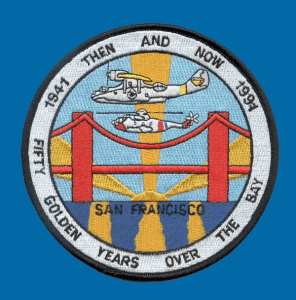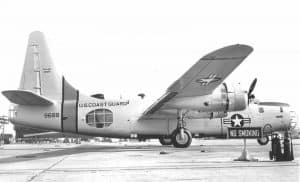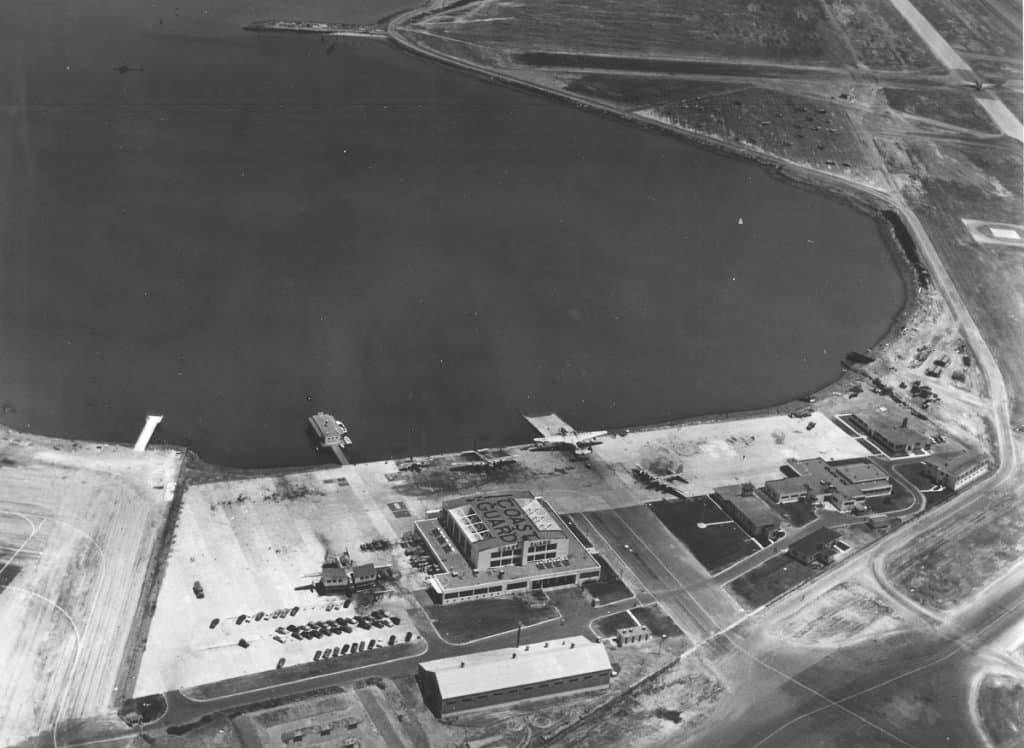 Coast Guard Aviation expanded significantly during a nine year period which saw the construction of nine aviation patrol stations along the coastlines of the United States. The Construction of the Coast Guard Air Station San Francisco was the last of this group. The station was constructed during 1940 on a 20.5 acre piece of property adjacent to San Francisco Airport, then known as Mills Field. The air station was formally dedicated on February 15, 1941, LT George H. Bowerman commanding. The facility was designed to operate seaplanes and also had access to the runways at Mills Field for landplane operations. The initial aircraft complement was a PBY-5 Catalina and two RD-4 Dolphins. The primary mission was the saving of life and property in the maritime environment.
Coast Guard Aviation expanded significantly during a nine year period which saw the construction of nine aviation patrol stations along the coastlines of the United States. The Construction of the Coast Guard Air Station San Francisco was the last of this group. The station was constructed during 1940 on a 20.5 acre piece of property adjacent to San Francisco Airport, then known as Mills Field. The air station was formally dedicated on February 15, 1941, LT George H. Bowerman commanding. The facility was designed to operate seaplanes and also had access to the runways at Mills Field for landplane operations. The initial aircraft complement was a PBY-5 Catalina and two RD-4 Dolphins. The primary mission was the saving of life and property in the maritime environment.
The Coast Guard was transferred to the Navy Department by executive order 8929 on November 1, 1941 and Air Station San Francisco was placed under the operational command of the 12th Naval District. In April 1942, the station was assigned to the operational control of the Commander, Western Sea Frontier, U. S. Navy. The Station continued to conduct Search and Rescue operations and commenced Coastal Patrols. Coast Guard and Navy personnel flew joint ASW patrols in OS2U-3 Kingfisher aircraft. The Coastal Patrols became limited as Japanese submarine activity on the West Coast of the United States was minimal during World War II. The station was also tasked with aiding in the construction of the highly classified and secret Long Range Navigation (LORAN) stations in the North Pacific during 1943. The Navy leased 85 acres at Mills Field and commissioned a Naval Auxiliary Airfield supporting Pan American which was flying under contract to the Navy. The Commanding Officer of the Coast Guard Air Station was also the Commanding Officer of the Naval Air Facility. In 1944, with the creation of responsibility for Air/Sea Rescue operations, the San Francisco Sector, consisting of Coast Guard aircraft, surface rescue craft, and facilities, was placed under the command of the Commanding Officer, Coast Guard Air Station San Francisco. At the end of the war the station returned to Coast Guard operational control and continued as a search and rescue unit.
 In addition to PBY-5A Catalinas the PB2Y Coronado flying boat had been flown out of San Francisco in the last years of World War II. In 1945 Boeing PB-1G flying fortresses were assigned and then replaced by P4Y-2G Privateers. In 1947 the first helicopter, a HO3S-1 Dragonfly arrived and was followed by the HO-4S. The HU-16 Albatross, known to many as the “Goat,” arrived in the 1950s and was supplemented by R5Ds until the C130s came on the scene. The HH-52 amphibious helicopter came on board in 1963.
In addition to PBY-5A Catalinas the PB2Y Coronado flying boat had been flown out of San Francisco in the last years of World War II. In 1945 Boeing PB-1G flying fortresses were assigned and then replaced by P4Y-2G Privateers. In 1947 the first helicopter, a HO3S-1 Dragonfly arrived and was followed by the HO-4S. The HU-16 Albatross, known to many as the “Goat,” arrived in the 1950s and was supplemented by R5Ds until the C130s came on the scene. The HH-52 amphibious helicopter came on board in 1963.
In 1978, due to space limitations and an increase in operational requirements, all fixed-wing aircraft were moved to the newly constructed Coast Guard Air Station Sacramento. San Francisco became a helicopter only air station. The HH-52As were replaced by HH-3F Pelicans which were in turn replaced by HH-60 J- Hawks. A restructuring within Coast Guard Aviation lead to the replacement of the HH-60s by the HH-65C in June of 1996. The HH65C are equipped for Airborne Use of Force.
While the airframes evolved, the primary mission of Air Station San Francisco remained unchanged for six decades – maritime search and rescue along 300 miles of coastline from Point Conception to Fort Bragg. In addition to SAR, Air Station San Francisco expanded its missions to include maritime law enforcement, environmental, aids to navigation, and logistics. In 2003, the USCG became part of the Department of Homeland Security, further expanding the Air Station’s role in protecting America’s shores and its citizens. This includes Airborne Use of Force missions.


